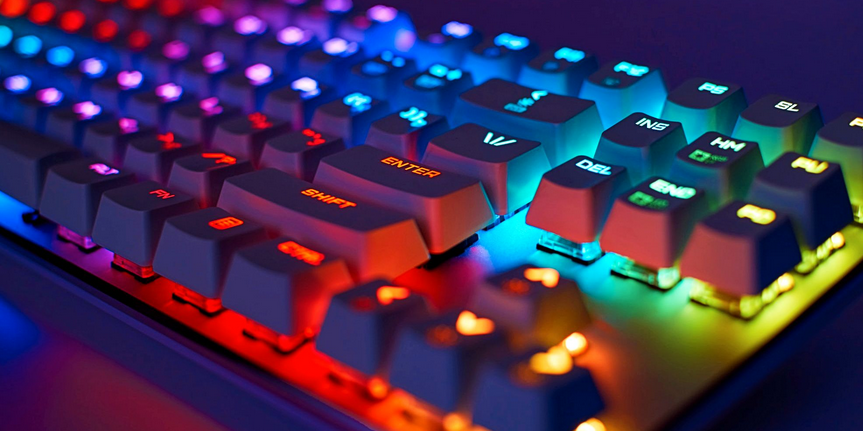If you have a mechanical keyboard, it is important that you take proper care of it to ensure it will last as long as possible. This will help you avoid having to buy a new one in the near future.
The best way to do this is to clean your mechanical keyboard regularly. This will prevent a build-up of dirt, germs and oils that can impede performance.
1. Wipe down the Surface
When it comes to maintenance and care for your mechanical keyboard, there are a few things you can do to keep it looking and functioning at its best. One of the most important things is to wipe down the surface, as this prevents dust and dirt from building up.
This can be done with a microfiber cloth, a regular rag, or a cleaning wipe. Just make sure to only use a small amount of cleaning agent so you don’t make the surface sticky and avoid brands that contain acid or bleach as these can cause damage to the keyboard.
Another way to clean the surface of your keyboard is to use a compressed air can (you can find these at hardware stores, computer shops, or even photo stores). Turn the can on and press a few short bursts of air between each keycap, catching as much loose debris as possible.
Using a compressed air can is also a good way to remove keycaps that are stuck on the keyboard. You can usually get these at any hardware store, and most of them come with a keycap puller.
If your keys are extremely dirty and hard to see, you might want to consider taking off the keys completely. This isn’t something you’ll want to do every time you clean your keyboard, but it’s a good idea to do once or twice a year.
Once the keys are off, you can gently clean them with a microfiber cloth or a cotton swab soaked in soap and water. Some people also like to soak the keycaps in a bowl of hot water with dishwashing liquid for an extra deep clean.
Once you’ve cleaned your keycaps, it’s time to reattach them. You should follow the same steps as you did to clean them, except you’ll need to take a picture of your keyboard layout so you can put them back in their proper place.
2. Clean Under the Keys
If you’ve been using your keyboard for a while, there’s likely a layer of dust, dirt, and debris hiding under the keys. These can include food particles, crumbs, pet hair, and other particles that get caught between the keycaps. This layer of grime can build up and prevent the keycaps from working properly.
One of the easiest ways to keep your keyboard clean is to wipe it down regularly. This can be done by wiping it down with a dry cloth and will help to keep the surface of the keys free from grit and grime.
This method of cleaning will also help to remove any spills or water that might have gotten on the keys. However, it is important to be careful when using this method because any liquid that comes into contact with the switches could fry them or cause damage.
You can also try using a brush to gently brush under the keys to remove any loose dirt or debris that may have settled in between the keycaps and the base of the keys. You can use a rubbing alcohol or dishwashing liquid mixture for this purpose.
Another way to clean under the keys is to vacuum them. You can use a handheld vacuum cleaner or a hose-type vacuum cleaner, but you should be very gentle with it to avoid getting any dust or dirt on the switches.
After you’ve cleaned the keys, be sure to put them back together again and make sure they are secure. This will prevent any accidental presses or re-presses and ensure your keycaps don’t come off.
3. Deep Clean the Keys
A good cleaning is key to the longevity and performance of a mechanical keyboard. It should be done a few times a year to help remove dust and grime that can accumulate and build up on the keys.
A thorough deep clean can also help your keys feel better and work more efficiently. To do this, you can use a toothbrush, a soft paintbrush, or even your fingernails to scrub away any accumulated dirt.
Alternatively, you can use a small handheld vacuum cleaner to get rid of any lingering dust. The best ones are those that don’t have rotating brushes and are easy to use with one hand.
This will allow you to get deep into the cracks between the keys without causing damage. You may need to use a little bit of pressure, but it should work just fine and get rid of most of the guck.
For the first part of the process, flip your keyboard upside down and shake it back and forth to loosen any clumps of dust or dirt that might be hiding under the keys. If you have a specialized cleaning brush for mechanical keyboards, this is a great time to use it.
You can also just use a piece of cloth or paper towel to wipe the surface of your keys. This will help prevent a build-up of dirt on the surface and will help you avoid accidentally scrubbing the keys with your fingers, which can cause scratches.
Finally, you can try soaking the keys in warm water and soap to degrease them. This can take an hour or so.
Once you’ve soaked your keys, you can wash them off with dishwashing liquid and water. This will make the keys soft and clean again.
4. Reassemble the Keys
If you have a mechanical keyboard, it’s likely that some keys will stop working. This is often the result of a dirty key switch or keycap. However, it’s also possible that the key isn’t working because there are other issues with the hardware.
Another way to fix a broken switch is by cleaning it. Use contact cleaner to remove any dirt or oil that’s clogging the switch and restore electrical contact. This works on both metal-switch and plastic-switch keyboards.
Once you’ve cleaned the switch, you can try using compressed air to help re-energize it. This can be especially helpful if you have a dead switch that won’t work.
You can do this by holding the plunger of the switch towards the side. This will create an opening for the air to go. Then, blast the air into the switch a few times.
Aside from this, you can also clean out the contacts. The contacts on a mechanical keyboard are made of metal and plastic, and they can get oily from the materials used to make them.
Luckily, you can easily clean the contacts on your keyboard without having to buy any special tools. Just make sure to keep the keyboard and switches as dry as possible so that no dust gets in.
Once you’re finished, you can reattach the stabilizers and keycaps. This will take some time, but it’s very easy to do if you know what you’re doing.
Conclusion
You can even change the keycaps to make them more unique. This is a great way to customize your keyboard and make it look a little more stylish. But, be careful not to yank the keycaps off the stem of the keyboard. This can damage the stem or yank out the switch altogether.






More Stories
Embark on Your American Journey: US Visa Guide for Citizens of Iceland and Ireland
Unlocking Opportunities: A Guide to US Visas for Mexican Citizens
a Canadian Adventure: A Comprehensive Guide to the